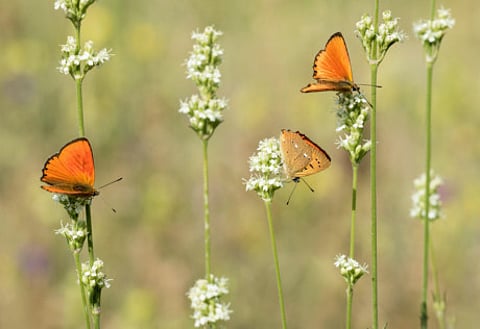A summer without butterflies
The ecosystem in my own yard is showing signs of both trouble and hope

How ragged we are now, dragging summer behind us like an old blanket we can’t set down. The homicidal heat of August has given way to the merely cruel heat of mid-September, but we are done with it even so. Everyone is cross, and not just the people.
The impatient squirrels bite into the green acorns and then fling them to the ground. Unripe, they lie in tatters under the white oak tree.
It has been a troubling summer in the yard. I have so much passionflower, the host plant for gulf fritillary butterflies, but this year there hasn’t been a single caterpillar on my passionflower vines. The parsley I planted for the black swallowtails is also unmolested. All summer long, I have seen just six butterflies. One was a female monarch, but she ignored all my milkweed plants, the only food monarch caterpillars can eat. Worn and faded, she stayed only long enough to feed from the zinnias.
What could explain a summer without butterflies? The late-spring freeze, the way habitat is diminishing all around me, my neighbours’ increasing reliance on pesticides? It’s been a scant year for butterflies in Middle Tennessee generally, according to friends with their own pollinator gardens, so perhaps this loss is owing to all of those reasons combined. I am so tired of this summer bereft of butterflies.
And yet.
The mornings are a gift. Cool and damp, they feel like part of an entirely different ecosystem. If I’m poking around the garden early enough, I can spy all the darling bumblebee butts deep in the bells of balsam flowers where the bees have tucked themselves in for sleep. One morning I brushed against a balsam stalk without meaning to, and the sleeping bee backed out of her bed, reared up, and waved her little bumblebee arms at me, buzzing furiously.
The nights, too, are filled with winged enchantment. I can’t see the migrating songbirds that fill our skies, but sometimes I can hear them. And I know from checking the Cornell Lab of Ornithology’s BirdCast predictions just how many are flying high above our dark house each night. By the tens of thousands, they pass above us, heading south. Their chittering cheers me, each voice belonging to a hollow-boned miracle of flight.
And if I make myself look carefully, I find that even the midday tedium of summer has its beauties, too.
Every afternoon, our fledgling red-tail hawk returns to the neighbourhood, crying as it flies. It has been crying for so long that at least one blue jay has learnt to copy it. I’ve seen a blue jay deploy an imitation hawk call as a way to clear a bird feeder of rivals, but I took all my seed-feeders down weeks ago. This jay seems mainly to be entertaining itself, calling out desperate baby hawk cries, just for the fun of it.
I took my feeders down because there’s no need for them this time of year. The spent zinnias and coneflowers and black-eyed Susans provide plenty of seeds, and the beautyberries, arrowwood berries and pokeweed berries are ripe now, too. They all feed our resident birds and any migrants that light in these trees on their long journey. Soon the acorns will be ripe, and the Eastern red cedar cones and the American holly berries — enough for the squirrels and everyone else.
I’m especially fond of the pokeberries, which I did not plant. Pokeweed seeds are planted by birds, falling to the soil in their droppings. I have two stands of pokeweed plants, and they are magnificent, magenta-limbed and 10 feet tall. Pokeberries appeal to fledglings who haven’t quite gotten the hang of catching insects yet, but nearly all the backyard songbirds help themselves from time to time, and hummingbirds fattening up for their own migration find the pokeweed branches a convenient roost above the nectar feeders.
Already the fall wildflowers are beginning to come into their own. The goldenrod throws its yellow plumes into the air; ironweed and asters purple the fields and roadsides; snakeroot blankets the forest understory; anise hyssop and elephant’s foot flowers call to the bees on the naturalised side of our yard. All of them feed the insects that feed the birds who need fuel for the migration, or for surviving the winter at home.
Not everyone will survive. A basilica orb-weaver spider has built her cathedral outside our front door. Her web has been pummeled by rains again and again, but her pearly egg sacs, all strung together in a row, are safe. Every day I check them to be sure, and every day their mother watches me warily as I check.
She will guard them faithfully until she dies, and the last thing she will do is secure the guy wires they’ll need to guide them when they climb out of their sacs next spring. I have never seen the translucent spiderlings emerge to run along those strands into safe cover, but I will keep watch when the time is right. Always hoping.
— Margaret Renkl is a contributing opinion writer who covers flora, fauna, politics and culture in the American South.
The New York Times.
Sign up for the Daily Briefing
Get the latest news and updates straight to your inbox



